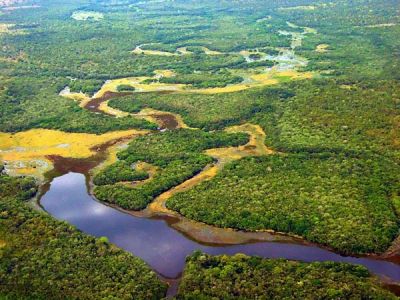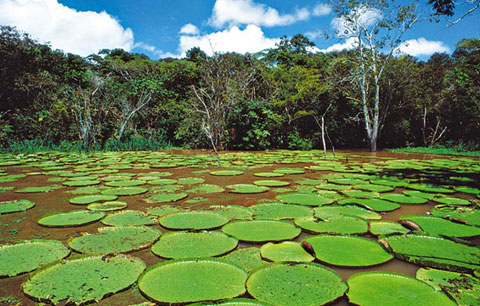Indispensable for life, source of natural wealth
Water
The next environmental commodity, its exploitation must be regularized for sustainable use in the future
Water Commercialization: Basic Principles
Commercialization of water has been regarded as the “next carbon” and plans to estimate the value and commercialize both the use of water and its inputs have proliferated in North and South America, Asia and Africa. The Ecosystem Marketplace looks at the basics of this promising ecosystem marketplace. April 16, 2008 | In the early 1980s, the de la Motte family realized that cattle manure and fertilizers were contaminating the aquifer that supplied the family's famous (and profitable) mineral water station in the town of Vittel, northeastern France, after upstream farmers replaced the natural marsh, which filtered the water, with corn.

By the end of the decade it was clear that the problem needed an innovative solution – a new Vittel owner, Nestlé, spent the 1990s trying to come to a conclusion with local farmers. The company purchased 600 acres of susceptible habitat and signed long-term conservation contracts with farmers whose corn and cattle had polluted the waters downstream.
Nestlé now pays farmers to treat animal waste, graze their dairy cattle as they used to, and reforest susceptible filtration zones. Despite being an expensive process, it is still much cheaper than the alternative. Competitor Perrier (now also owned by Nestlé) once spent over US$ 260 million on a product recall after there was a benzene spill in millions of its well-known green bottles, and it never managed to regain its share of the market.
Payments for Ecosystem Services
The Vittel action, like the payment to farmers in upstate New York City, has become an academic example of a successful PSE business – an acronym for Payments for Ecosystem Services – or, in this case, “payments for watershed services”. hydrographic systems” (PSBH). These plans, as regular visitors to this site know, are based on the premise that ecosystems provide valuable services that we take for granted – such as water filtration in the aforementioned example – but whose value our economy usually doesn't account for.
PSE plans attempt to quantify the economic value of the services an ecosystem provides and then encourage or compel beneficiaries to pay the people who maintain that service. Unfortunately, for every successful PSE plan, there are records of failures and near-failures, as well as a great deal of debate about what works and what doesn't.
Water Commercialization: Quantity and Quality
The Kyoto Protocol has everyone turning their eyes to the trading of greenhouse gas emissions and offsets. However, in fact, emissions trading began decades before the Kyoto Protocol was signed. The United States Environmental Protection Agency (EPA) Emission Trading Program began in 1974 and allows for a limited exchange of emission reduction credits for five air pollutants: volatile organic compounds, carbon monoxide, sulfur dioxide, particulate matter and nitrogen oxides. He contributed to the apex of the environmental movement in the United States. The first Earth Day was fresh in everyone's memory and the Clean Water Act (CWA) and the Endangered Species Act were laying the groundwork for today's water and biodiversity markets.
A Savings Account for Wetlands
So-called “mitigation banking” covers the amount of biodiversity and wetlands, which are more than stagnant bodies of water. A well-functioning wetland plays a critical role in filtering water and therefore “provides” the ecosystem service of reliable water quality, as well as serving as a habitat for many plants, insects and animals that are part of a biodiversity. area. These “services” are difficult to quantify, and so environmentalists are armed against plans that replace true wetlands with lakes and other isolated bodies of water.
Mitigation banking services involve the creation of capital reserves of water, being a key response to section 404 of the CWA.
The Act mandates that anyone who intends to dredge a wetland that feeds other watersheds should try to find a way to prevent the destruction of that wetland. When this is not possible, the developer must first obtain a permit through a program administered by the US Army Corps of Engineers and the US EPA. Then, if permission is granted, the developer must “establish, improve, restore or preserve” an amount of wetland equivalent to, or greater than, the area to be dredged, usually in the same watershed.
Mitigation banks are essentially wetlands that have been efficiently created, improved, restored or preserved in exceptional circumstances, when land was under significant threat, to generate credits that can later be sold to developers as compensation.
The CWA requires mitigation banks to replace the function as well as the impaired wetland area, although many complain that the function requirement is often overlooked.

The Motivation for Distribution
In addition, there are plans that cover the distribution of drinking and agricultural water, and no one has taken this further than the Australians, who have turned water into a product that is almost as easily traded as electricity in other parts of the developed world.
But it is in the developing world that these plans could have their greatest impact. Studies reveal that typically the poorest pay more for clean drinking water, while many industries simply waste this water for free. Commercialization could establish a uniform price for the clean water supplied and thus both reduce industrial waste and enable supply to areas that currently have little access to potable water.

